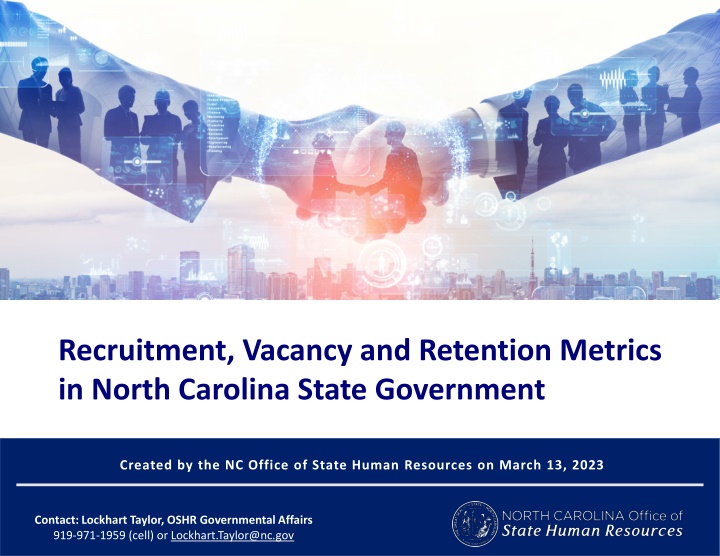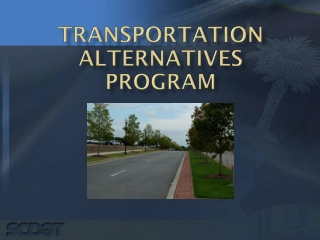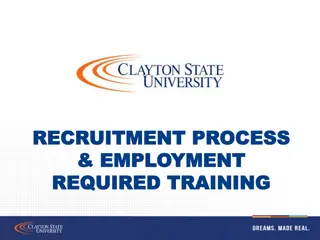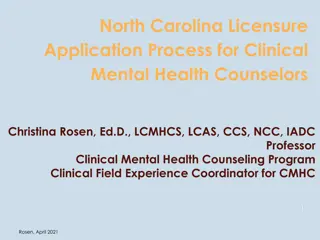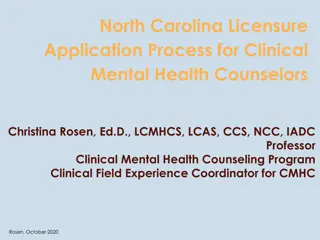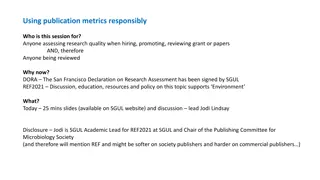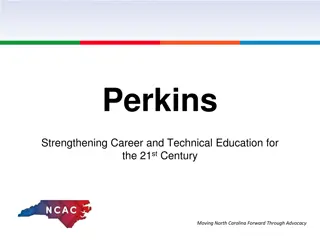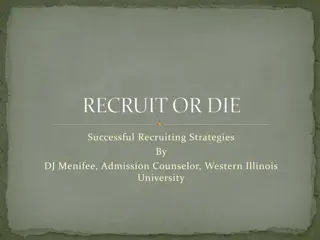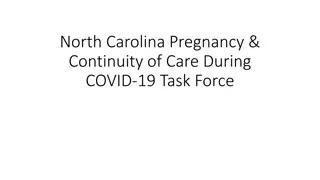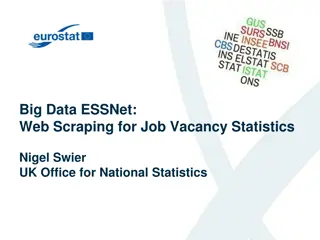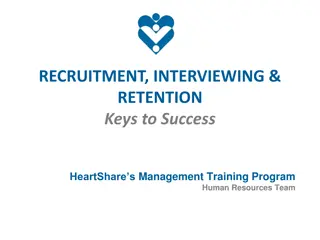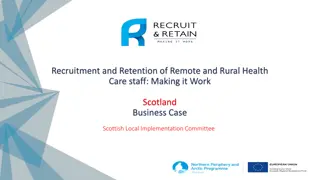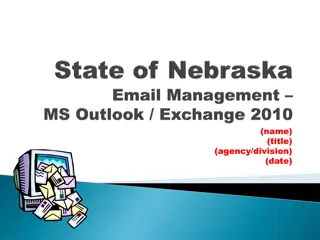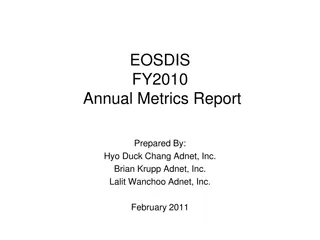Recruitment, Vacancy and Retention Metrics in North Carolina State Government
Challenges persist in recruiting and retaining a skilled workforce in North Carolina's state government as vacancies rates remain high and turnover rates soar. The decline in applications for state jobs has led to prolonged hiring processes and numerous unfilled positions, impacting crucial public services across various agencies. Significant obstacles include low application numbers, job repostings due to lack of qualified candidates, and hiring delays due to overburdened HR staff. The consequences of high vacancies are felt in essential sectors such as corrections and healthcare, affecting service delivery and personnel safety. Strategic actions are needed to address these persistent staffing challenges and enhance workforce sustainability in state agencies.
Uploaded on Mar 26, 2024 | 9 Views
Download Presentation

Please find below an Image/Link to download the presentation.
The content on the website is provided AS IS for your information and personal use only. It may not be sold, licensed, or shared on other websites without obtaining consent from the author.If you encounter any issues during the download, it is possible that the publisher has removed the file from their server.
You are allowed to download the files provided on this website for personal or commercial use, subject to the condition that they are used lawfully. All files are the property of their respective owners.
The content on the website is provided AS IS for your information and personal use only. It may not be sold, licensed, or shared on other websites without obtaining consent from the author.
E N D
Presentation Transcript
Recruitment, Vacancy and Retention Metrics in North Carolina State Government Created by the NC Office of State Human Resources on March 13, 2023 Contact: Lockhart Taylor, OSHR Governmental Affairs 919-971-1959 (cell) or Lockhart.Taylor@nc.gov
Recruitment, Vacancy and Retention Metrics in North Carolina State Government Challenges continue with recruiting and retaining an effective workforce. Agencies are competing for applicants and employees with private-sector and other public-sector employers. Applications for state jobs have fallen, causing increases in the vacancy rate and the turnover rate remains high. Problem 1: Unfilled Jobs High Vacancy Rates and Lower Employee Headcount Vacancy rates: Among the agencies most impacted in 2022 Adult Correction/Public Safety (27.1%) Health and Human Services (25.9%) Transportation (21.7%) State Auditor (21.3%) Environmental Quality (18.8%) Military and Veteran Affairs (16.8%) Administration (16.6%) North Carolina Population NC State Employee Headcount vs. Total Positions 10700000 76,000 10600000 74,000 72,000 10500000 70,000 10400000 68,000 10300000 66,000 10200000 64,000 62,000 10100000 60,000 10000000 58,000 9900000 56,000 9800000 Dec. 2020 Dec. 2021 Dec. 2022 2013 2014 2015 2016 2017 2018 2019 2020 2021 2022 Headcount Total Positions All N.C. state government executive branch agencies. Source: HR-Payroll System, analyzed by Office of State Human Resources. Source: U.S. Census Bureau Source: HR-Payroll System, analyzed by OSHR High vacancy rates slow processes, fuel burnout and impact the ability of agencies to effectively recruit, hire and retain a qualified workforce. While the number of North Carolinians is rising, the number of state employees is decreasing. -- State Human Resources Director Barbara Gibson Fewer Applications, Longer Delays Because fewer people are applying for state jobs, many positions remain unfilled for months, impacting services. 93% of salary-related hiring actions are delegated to be completed entirely by agency staff. 7% come to OSHR. Major factors cause hiring delays: Job Postings Applications Over the past four years, we have seen a near 50% reduction in the number of applications. This means fewer qualified applicants and often we don t get a single qualified applicant, or we get ghosted. It is discouraging to not have anyone to interview because that interview gives us a shot to pitch coming to work for the department. Receiving fewer applications results in jobs being reposted over and over. 1. Reposting positions due to lack of qualified applicants. 2. Delays by overworked hiring managers and overworked agency HR staff. -- Chief Deputy Commissioner N. David Smith, Department of Agriculture and Consumer Services 51% 43% All N.C. state government executive branch agencies. Comparing 2019 to 2022. Source: NEOGOV Page 1
Corrections Problem 1: Unfilled Jobs, Continued Job Title Total Positions Turnover Rate Vacancy Rate Real World Consequences Correctional Officer I 1,718 32.2% 36.2% While North Carolina continues to grow, the number of state employees is decreasing--even with more state government positions. Higher vacancies make it hard to provide vital state services to the public. People feel the strain with longer lines at the DMV and fewer available beds in state hospitals. Personnel shortages in prisons and juvenile justice facilities put officers and other employees at risk of injury. Correctional Officer II 3,727 29.6% 48.5% Correctional Officer III 3,568 22.3% 39.3% I don t see a quick fix to significant staff challenges that we have. In 2021, we lost more than we hired as an agency. In 2022, on the prison side, we broke even. -- Secretary Todd Ishee, Department of Adult Correction, told lawmakers at his confirmation hearing When the number of state employees decreases, North Carolinians feel the strain. Health Care Job Title Total Positions Turnover Rate Vacancy Rate Division of Motor Vehicles Registered Nurse 1,202 30.3% 48.3% Total Positions Turnover Rate Vacancy Rate Job Title Health Care Technician I 3,843 35.3% 37.4% 465 18.3% 22.8% Driver License Examiner I Health Care Technician II 629 22.1% 26.3% Licensed Practical Nurse 558 26.8% 42.5% It is our plan to go back to the legislature to ask for their help. Because that is the dominant reason for the difficulty in hiring, is having a good starting salary to attract folks and to keep quality personnel. Like hospitals across the state, we're experiencing record vacancies. Ours doubled in 2 years to 24%. This impacts how many patients we can serve, many of whom have the most complex healthcare needs in the state. -- Commissioner Wayne Goodwin, Division of Motor Vehicles, Department of Transportation, CBS17 -- Secretary Kody Kinsley, Department of Health and Human Services, Twitter Problem 2: Retaining Employees Retirement Eligibility in the Next 5 Years Retirement eligibility within 5 years: Among agencies most impacted in 2022 An Aging State Government 8.5% of agency employees are eligible to retire with full, unreduced benefits now. 26.1% of agency employees will be eligible to retire with full, unreduced benefits in 5 years. The median age of a North Carolina state government employee is 48, compared to 42 for employees in the national workforce. * State Human Resources (39%) Administrative Hearings (36%) Commerce (36%) Labor (35%) State Controller (33%) Administration (33%) Insurance (32%) Information Technology (32%) * 26.1% *Eligible to retire with full, unreduced benefits. Source: HR- Payroll System, analyzed by Office of State Human Resources. 73.9% Page 2
Turnover Rate Problem 2: Retaining Employees, Continued Turnover rates: Among the agencies most impacted in 2022 State Budget and Management (22.6%) State Auditor (21.9%) Commerce (21.4%) Military and Veterans Affairs (21.3%) Health and Human Services (20.9%) Community Colleges (19.5%) Adult Correction/Public Safety (18.4%) Turnover Turnover increased rapidly in 2021 by historic standards, then slightly decreased in 2022. Turnover dropped by the largest amount shortly after the July 2022 Legislative Increase (LI) for all employees and the targeted Labor Market Adjustment Reserve (LMAR). Losing an employee can cost from tens of thousands of dollars to twice their annual salary. Dec. 2020 Dec. 2021 Dec. 2022 Annualized turnover (based on prior 12 months). Source: HR-Payroll System, analyzed by Office of State Human Resources. Source: Deloitte First-Year turnover: Among the agencies most impacted in 2022 Turnover is Much Higher in First Year Segments where turnover is highest First-Year Employees People are most likely to leave state employment during their first year on the job. Health and Human Services (49%) Adult Correction/Public Safety (46%) State Human Resources (44%) Insurance (42%) State Auditor (39%) Labor (34%) Administration (32.6%) Revenue (31.3%) Employees paid below the market midpoint Employees are more likely to leave if they are below the midpoint of the market-based salary range. 71% of non-retirement turnover at all agencies was for employees below midpoint, even though only 53% of all agency employees are below midpoint. Annualized turnover, measured from January - December 2022. Source: HR-Payroll System, analyzed by Office of State Human Resources. What is the midpoint? I m having trouble sleeping at night, I m going to be quite honest with you, because of safety. I m worried about our staff. In state agencies systems, each job classification is assigned a salary range based on compensation in the labor market. The midpoint is the middle point of the salary range assigned to a job classification. It is the salary level at which a fully experienced employee might be paid. -- Deputy Director William Lassiter, Division of Juvenile Justice and Delinquency Prevention, Department of Public Safety, WRAL Page 3
Problem 3: Lagging Pay Legislative Increases Compared to Inflation (last 10 years) [W]e currently have close to a 25% vacancy rate in the positions allotted for compliance. To add positions and recruit new compliance officers, we have to provide a more competitive salary. This pay gap reduces the appeal of state jobs compared to the private sector and other government jobs. State employee pay lags behind inflation by North Carolina is falling behind other states, with Florida providing a 5.38% Legislative Increase and Georgia providing $5,000 COLA in 2022. Targeted funds were also given to their state employees. 9.1% -- Commissioner Josh Dobson, Department of Labor Up 3.9%; 5.1% cmpd.* Comparison of N.C. State Employee Annual Pay Increases to Labor Market Movement 2013-2022 35% State employee pay lags behind market by 14.8% total over last 10 years Up 3.0%; 3.8% cmpd.* 30% Up 2.6%; 3.2% cmpd.* Up 3.35%; 3.9% cmpd.* 25% Up 2.95%; 3.4% cmpd.* Total Impact Over Ten Years 20% Up 2.9%; 3.3% cmpd.* Up 3.5%; 4.1% cmpd.* Up 2.9%; 3.1% cmpd.* 15% Up 2.5%; 2.8% cmpd.* Up 2.9%; 3.1% cmpd.* Up 2.5%; 2.8% cmpd.* 10% Up 2.95%; 3.05% cmpd.* Up 2.5%; 2.7% cmpd.* Up 2.0%; 2.1% cmpd.* Up 2.85% 5% Up $1,000 (2.0%); 2.0% cmpd.* Up 1.5%; 1.5% cmpd.* 2016 Up 0.0% Up $1,000 (2.0%); 2.0% cmpd.* 2014 Up 0%; 2.0% cmpd.* 2015 0% 2012 2013 2017 2018 2019 2020 2021 2022 Annual labor market movement (compounded) Annual pay increase for employees (compounded) *Note: cmpd. means the compounded effect of this pay increase in addition to the increases shown earlier in the graph. See Data Sources and Date on page 8 for full information on sources and methodology for chart. These comparisons do not include the effect of the Labor Market Adjustment Reserve (LMAR) in 2022. If LMAR were included, the 9.1% and 14.8% numbers on this page would each be approximately 1.0% less. Page 4
Implemented Solutions OSHR has already taken several steps to help state government better recruit and retain employees. Improved non-monetary programs to attract employees More telework/hybrid work options Paid Parental Leave for employees at all cabinet and other participating state agencies More compensation options for agencies Added market-based pay factors, allowing agencies to go beyond the mathematical years of education and experience when setting pay within the salary range Distinguishing specific skills Specialized certifications Recruitment/retention issues specific to the current labor market Personal Observance Leave available at all cabinet and other participating state agencies Allows agencies to offer an additional day of leave to match our competitors for jobs in federal and local government Increased salary flexibility for agencies 93% of salary-related actions in 2022 were completed by agencies without need of OSHR approval. In addition, OSHR granted agencies expanded authority for new hires and in-range increases (up to 20% for most classifications or $20,000, whichever is greater), plus sign-on and retention bonus authority, effective March 13, 2023. Improved state policies on recruitment Implemented retention bonuses Ended salary history questions on state applications that created a barrier to equal pay for equal work Increased ability to hire trainees Expanded sign-on bonuses Added referral bonus pilot program for key classifications Built better state HR infrastructure Conducted detailed labor market study with global consultant Mercer Produced June 2022 update to the market-based compensation system Fair Chance Hiring Clear guidance about when agencies can use search firms for recruiting Invested in data governance for HR metrics Faster and better reference checks Page 5
Potential Solutions Improve recruiting Statute changes to improve recruitment Pooled hiring Lets applicants be automatically considered for other open positions. In Section 1 of 2023 House Bill 223. Expand continuous posting authority Authority for OSHR to approve continuous posting requests directly and immediately, rather than waiting for next HR Commission meeting. In Section 1 of 2023 House Bill 223. Surge Team to support state agencies in screening applications, expediting interviews and hiring for critical positions Increase job marketing and branding through dedicated funds and positions Partner with a contractor to review the state application form and how it can be simplified Same-day hiring Give flexibility to hire at end of interviews, conditional on reference checks. Provide training and resources related to Executive Order 278, Recognizing the Value of Experience in State Government Hiring Improve employee benefits More vacation leave for new employees Extend longevity pay (aka retention pay) and start it earlier Financial and infrastructure possibilities to meet the demands of this labor market Meaningful raises for all employees Labor Market Adjustment Reserve for targeted positions Resources to bring people to the minimum of their market-based salary range What can be done to lower employees family health insurance premiums? Resources to study the impact of offering additional benefits and how state benefits compare to the competition Competing against private employers who offer child care Competitiveness of health care benefits Competitiveness of retirement benefits Retirement portability Investment in improvements to state HR information systems Immediate improvements in HR technology Long-term improvements: Human Capital Management systems Page 6
Potential Solutions, Continued Creative Options (Now and In the Future) Dedicated resources for salary increases may be needed at some agencies where employees are especially below the market Contact: Lockhart Taylor OSHR Governmental Affairs 919-971-1959 (cell) or Lockhart.Taylor@nc.gov This document was produced on March 13, 2023, by OSHR. Key Terms and Data Sources for this handout: Headcount: The number of active permanent full-time, part-time, and time- limited State employees. Includes SHRA and EHRA employees. Data updated in 3rd week of month. Vacancy Rate: Number of vacant positions at the end of a selected period total number of positions at the end of the period. Data last updated in third week of each month. Turnover Rate: Number of separations in a selected period average headcount in that period. Data last updated in third week of each month. Retirement Rate: Number of retirements in a selected period average headcount in that period. Data Inclusion/Exclusion: This data set includes all state agencies, excluding Judicial Branch and School of Math & Science. Temporary employees, students, contractors, and universities are also excluded. Expansion of sign-on and retention bonuses A dedicated, nonrecurring source for bonus resources could help agencies meet current needs while retaining flexibility for the future Authority for premium pay to be competitive with market Examples: In critical operational areas (such as 24/7 operations) Where necessary to fill vacant jobs in particular areas/classifications Mentor bonus Increased resources for job-specific tuition assistance Data Sources and Date: Except where otherwise noted, all data are as of December 31, 2022 and were extracted by the N.C. Office of State Human Resources from the State HR/Payroll System (BEACON). In addition to the sources cited immediately below the graphs and charts on the previous pages, please note the following sources. Page 1: Quotes from Smith and Gibson provided directly to OSHR. Page 2: Goodwin quote from CBS-17 story by Michael Hyland, NCDMV to ask legislature for pay increases amid worker shortage (Jan. 5, 2023). Kinsley quote from Twitter (Aug. 5, 2022). Page 3, Deloitte figure: Josh Bersin, Global Industry Analyst for Deloitte, in Employee Retention Now a Big Issue: Why the Tide Has Turned (Aug. 16, 2013). Page 3, Lassiter quote: WRAL story by Matt Talheim, Leaders worry staff shortages in Department of Public Safety put public at risk (Nov. 11, 2022). Page 3, information on turnover below midpoint: Turnover data from June 1, 2022 (date when new salary range system became effective) through Dec. 31, 2022. Employees below midpoint as of Dec. 31, 2022. Source: HR-Payroll System, analyzed by OSHR. Page 4, information about other states: For summary of Florida state budget, see WTSP-TV article, Gov. DeSantis signs $109.9 billion state budget. What s in it? (June 6, 2022). For summary of Georgia state budget provisions on employee compensation, see State of Georgia Fiscal Year 2022 Workforce Report, 2021-2022, p. 4. Page 4, quote: Provided directly to OSHR. Page 4, graphic and chart: Compares annual increases in the state appropriations act to inflation (from June each year) and the average of the labor market salary increases reported by Mercer and WorldatWork. Sources: Mercer 2022 U.S. Compensation Planning Survey (Monthly Pulse) (November Edition), 2022-23 U.S. WorldatWork Salary Budget Survey (August 2022), and U.S. Department of Labor/Bureau of Labor Statistics, compared to OSHR compilation of annual increases for all state employees in each year s appropriations act. Chart shows compounded figures, including compounded effect of each increase upon previous increases. For more detailed charts without compounding, see OSHR 2022 Compensation and Benefits Report (filed Feb. 2023), pp. 7-8 and 32-33, available at this link. Pair raises/LMAR with funds to augment receipt- supported positions since grants and receipts cannot always be adjusted Could be limited to first year, to give agencies time to obtain funds Page 7
